Oil Palm Bunch Ripeness Classification and Plantation Verification Platform: Leveraging Deep Learning and Geospatial Analysis and Visualization
Abstract
:1. Introduction
2. Review of Related Literature
2.1. Oil Palm Ripeness Classification Using Machine Learning
2.2. Oil Palm Plantation Management Using GIS and Remote Sensing
3. Materials and Methods
3.1. Study Area
3.2. Data Collection and Preparation
3.3. Oil Palm Ripeness Classification
3.4. Accuracy Assessment
3.5. System Analysis and Design
4. Results and Discussion
4.1. Oil Palm Ripe Classification Result
4.2. Platform Implementation Result
4.3. Discussion
5. Conclusions
Author Contributions
Funding
Data Availability Statement
Acknowledgments
Conflicts of Interest
Appendix A
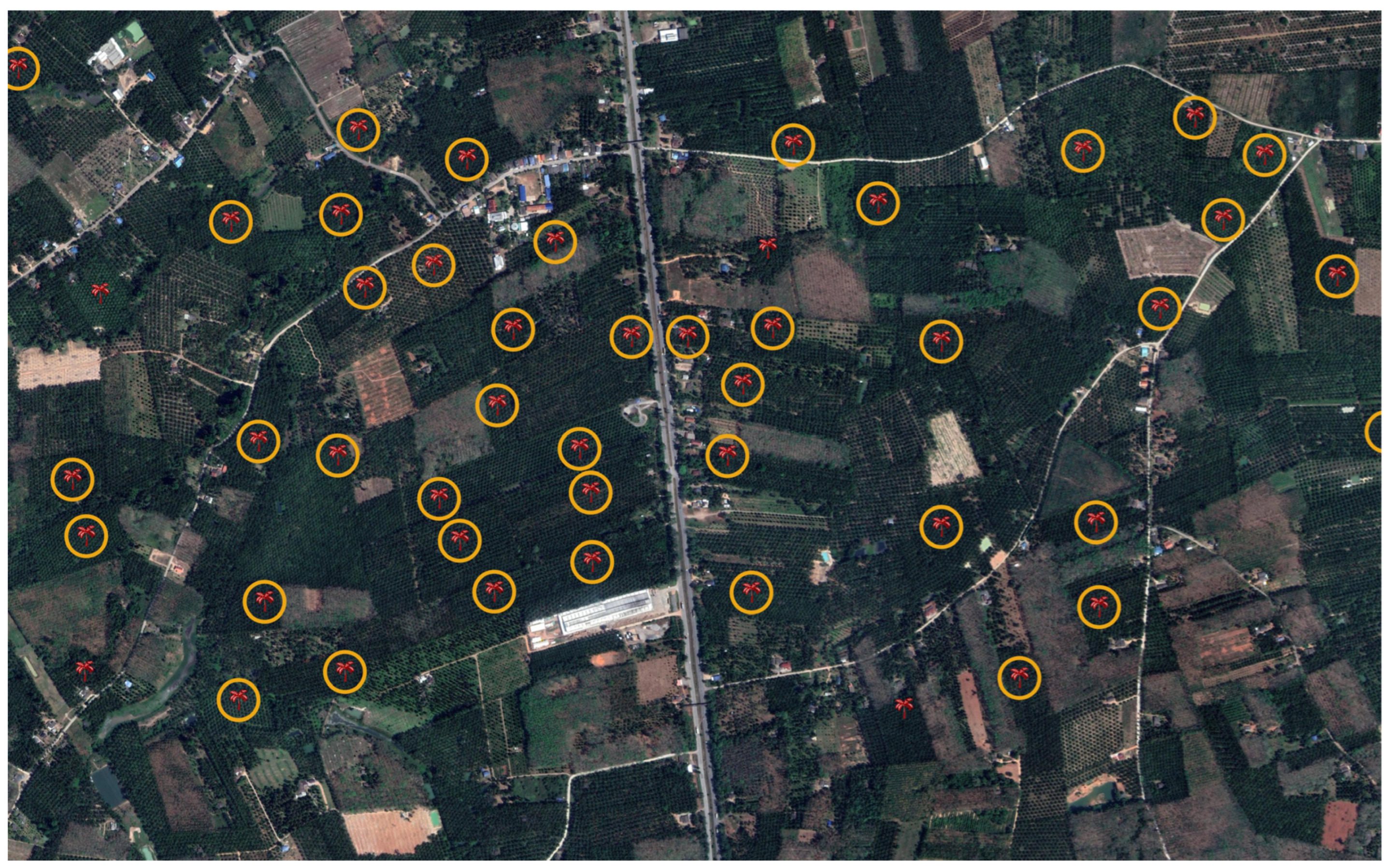
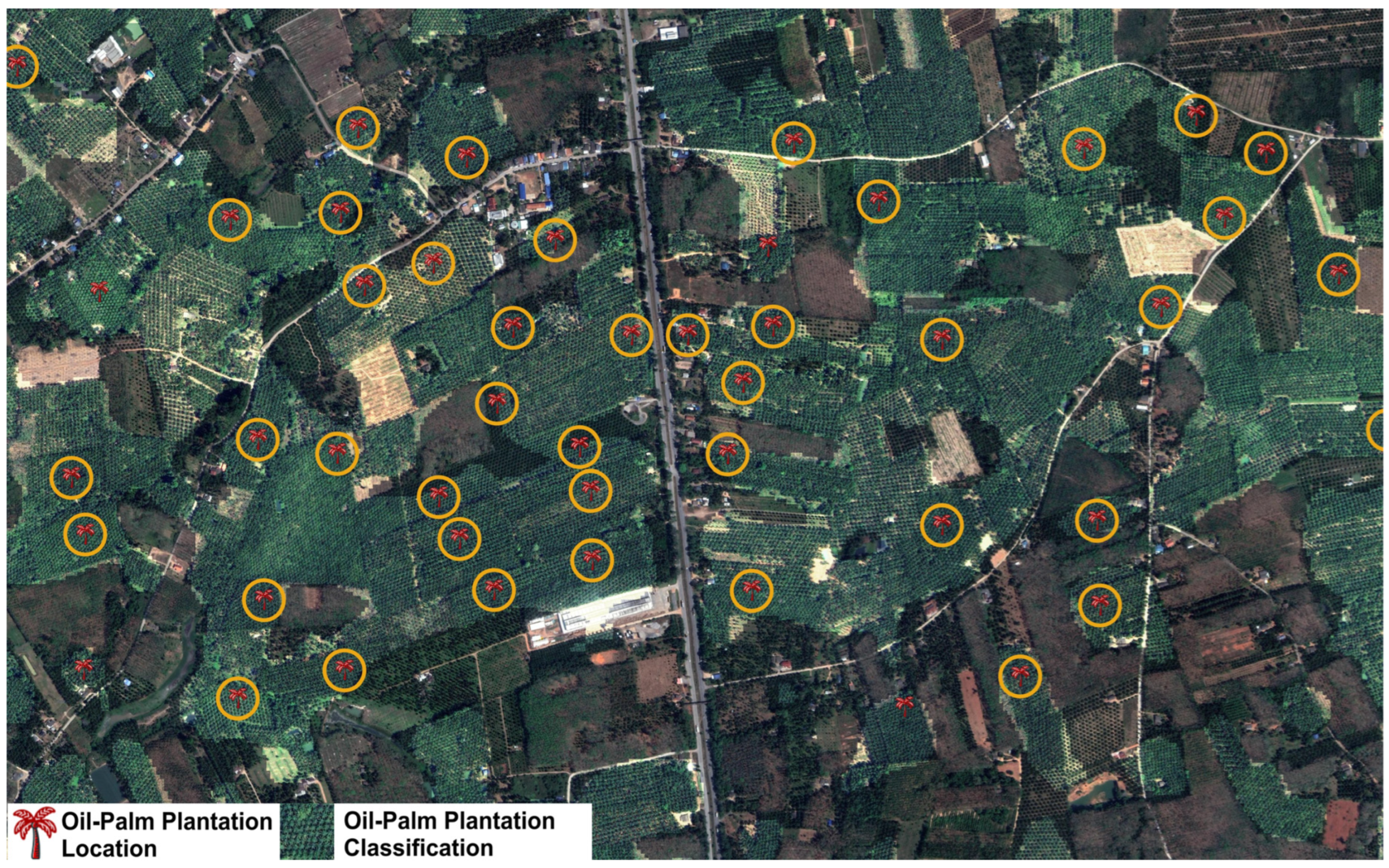
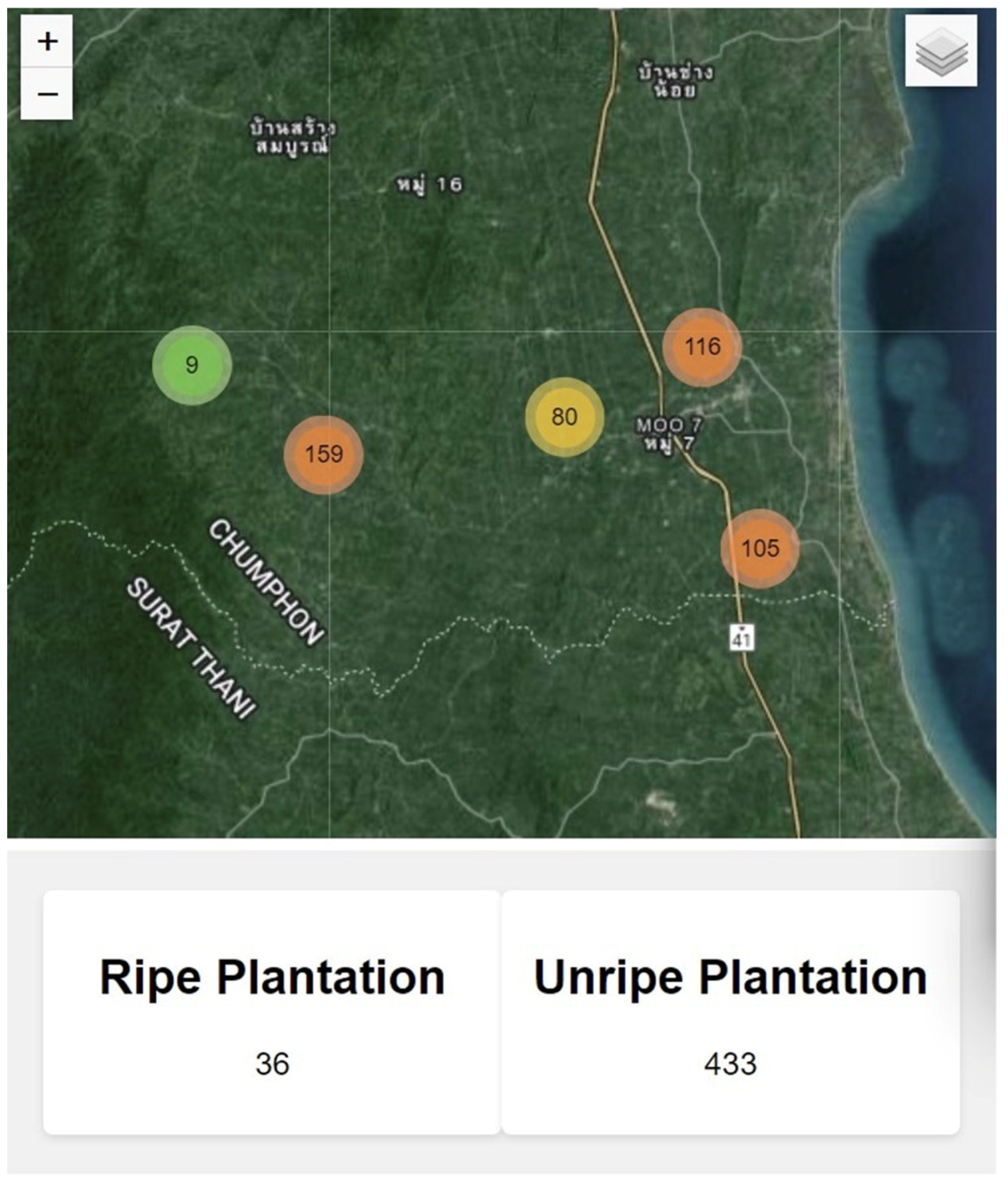
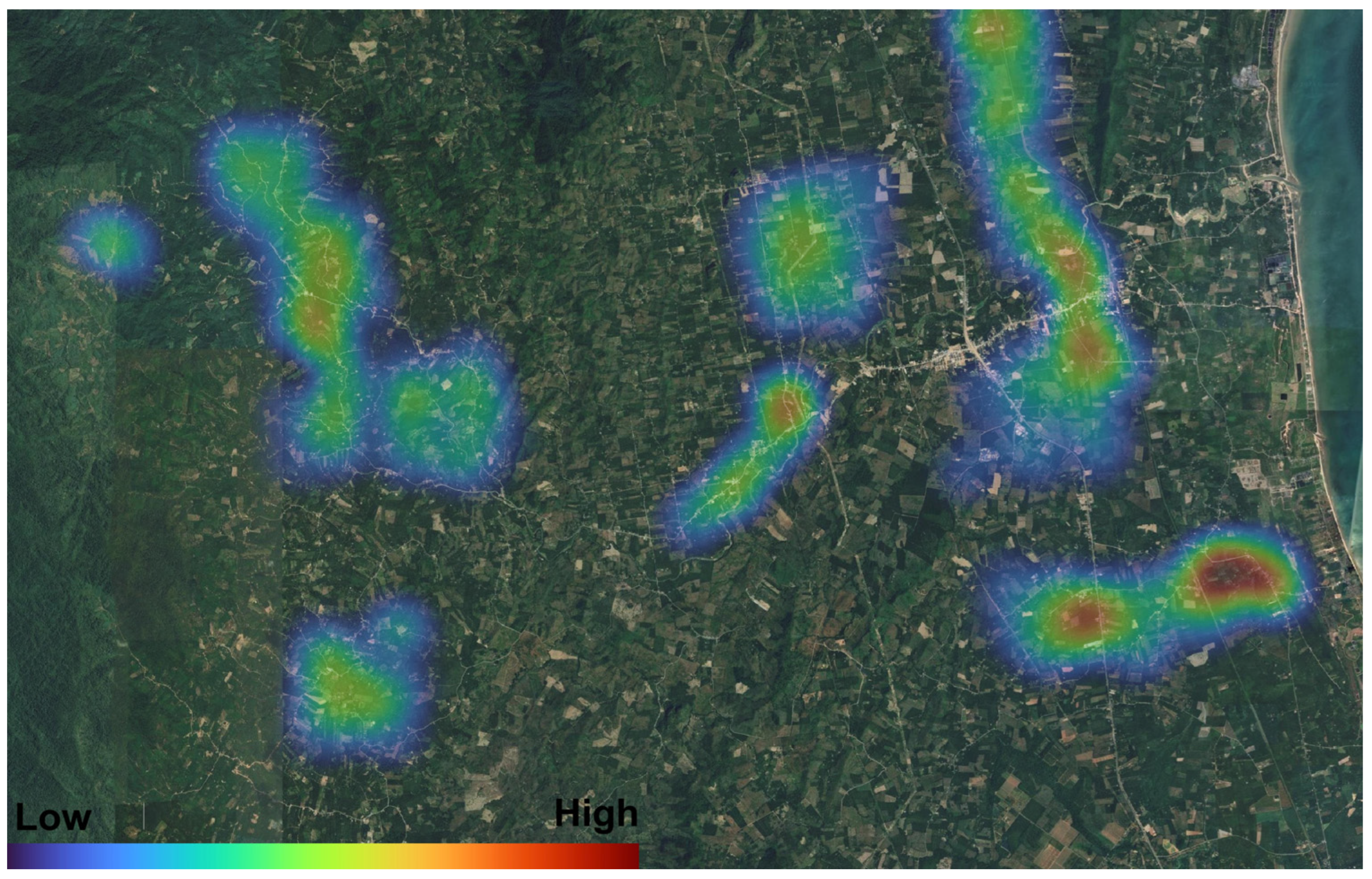
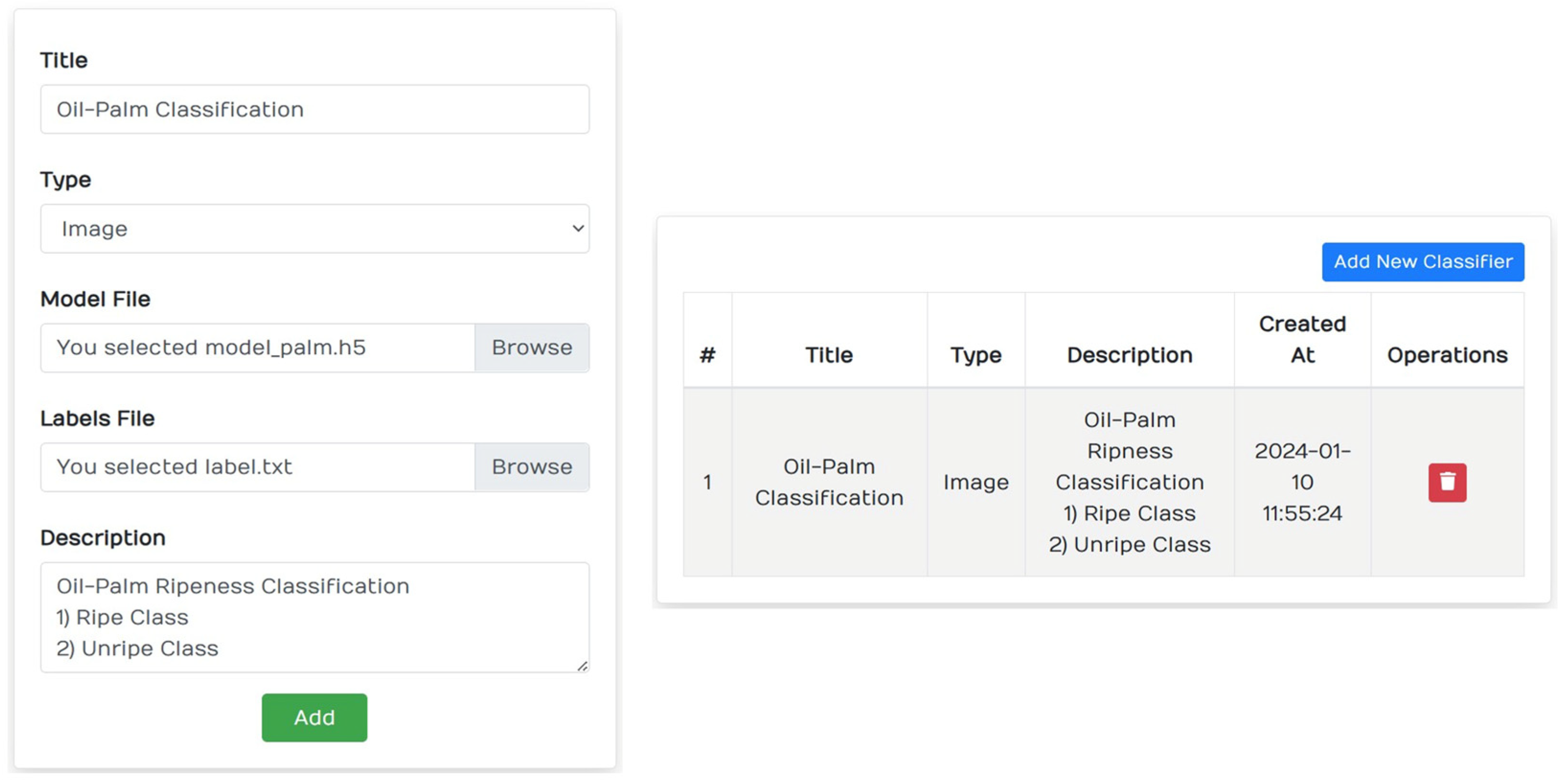
References
- Appelt, J.L.; Saphangthong, T.; Malek, Ž.; Verburg, P.H.; van Vliet, J. Climate change impacts on tree crop suitability in Southeast Asia. Reg. Environ. Change 2023, 23, 117. [Google Scholar] [CrossRef]
- Nupueng, S.; Oosterveer, P.; Mol, A.P. Global and local sustainable certification systems: Factors influencing RSPO and Thai-GAP adoption by oil palm smallholder farmers in Thailand. Environ. Dev. Sustain. 2023, 25, 6337–6362. [Google Scholar] [CrossRef]
- Yaseen, M.; Thapa, N.; Visetnoi, S.; Ali, S.; Saqib, S.E. Factors Determining the Farmers’ Decision for Adoption and Non-Adoption of Oil Palm Cultivation in Northeast Thailand. Sustainability 2023, 15, 1595. [Google Scholar] [CrossRef]
- Parveez, G.K.A.; Omar, A.R.; Ahmad, M.N.; Mat Taib, H.; Mohd-Bakri, M.A.; Sitti-Rahma, A.H.; Zainab, I. Oil palm economic performance in Malaysia and R&D progress in 2022. J. Oil Palm Res. 2023, 35, 193–216. [Google Scholar]
- Hashemvand Khiabani, P.; Takeuchi, W. Assessment of oil palm yield and biophysical suitability in Indonesia and Malaysia. Int. J. Remote Sens. 2020, 41, 8520–8546. [Google Scholar] [CrossRef]
- Paterson, R.R.M. Future climate effects on basal stem rot of conventional and modified oil palm in Indonesia and Thailand. Forests 2023, 14, 1347. [Google Scholar] [CrossRef]
- Paterson, R.R.M. Future Climate Effects on Yield and Mortality of Conventional versus Modified Oil Palm in SE Asia. Plants 2023, 12, 2236. [Google Scholar] [CrossRef] [PubMed]
- Muhadi, N.A.; Abdullah, A.F.; Muhammad Zahir, N.Z. Estimating Flood Losses in Oil Palm Plantation Using Flood Modeling. In ICDSME 2019: Proceedings of the 1st International Conference on Dam Safety Management and Engineering; Springer: Berlin/Heidelberg, Germany, 2020; pp. 359–367. [Google Scholar]
- Parveez, G.K.A.; Hishamuddin, E.; Loh, S.K.; Ong-Abdullah, M.; Salleh, K.M.; Bidin, M.N.I.Z.; Idris, Z. Oil palm economic performance in Malaysia and R&D progress in 2019. J. Oil Palm Res. 2020, 32, 159–190. [Google Scholar]
- Abubakar, A.; Ishak, M.Y.; Makmom, A.A. Nexus between climate change and oil palm production in Malaysia: A review. Environ. Monit. Assess. 2022, 194, 262. [Google Scholar] [CrossRef]
- Khor, J.F.; Ling, L.; Yusop, Z.; Tan, W.L.; Ling, J.L.; Soo, E.Z.X. Impact of El Niño on oil palm yield in Malaysia. Agronomy 2021, 11, 2189. [Google Scholar] [CrossRef]
- Lim, F.K.; Carrasco, L.R.; Edwards, D.P.; McHardy, J. Market responses to oil palm intensification could exacerbate deforestation in Indonesia. Conserv. Biol. 2023, 38, e14149. [Google Scholar]
- Gaveau, D.L.; Locatelli, B.; Salim, M.A.; Husnayaen; Manurung, T.; Descals, A.; Sheil, D. Slowing deforestation in Indonesia follows declining oil palm expansion and lower oil prices. PLoS ONE 2022, 17, e0266178. [Google Scholar] [CrossRef]
- Zhao, J.; Elmore, A.J.; Lee, J.S.H.; Numata, I.; Zhang, X.; Cochrane, M.A. Replanting and yield increase strategies for alleviating the potential decline in palm oil production in Indonesia. Agric. Syst. 2023, 210, 103714. [Google Scholar] [CrossRef]
- Nupueng, S.; Oosterveer, P.; Mol, A.P. Governing sustainability in the Thai palm oil-supply chain: The role of private actors. Sustain. Sci. Pract. Policy 2022, 18, 37–54. [Google Scholar] [CrossRef]
- Somnuek, S.; Slingerland, M.M.; Grünbühel, C.M. The introduction of oil palm in Northeast Thailand: A new cash crop for smallholders? Asia Pac. Viewp. 2016, 57, 76–90. [Google Scholar] [CrossRef]
- Saechen, P.; Siriborvornratanakul, T. Oil Palm Fresh Fruit Bunch Ripeness Classification by Deep Learning. KMUTT RD J. 2023, 6, 81–104. [Google Scholar]
- Suharjito; Junior, F.A.; Koeswandy, Y.P.; Debi; Nurhayati, P.W.; Asrol, M.; Marimin. Annotated Datasets of Oil Palm Fruit Bunch Piles for Ripeness Grading Using Deep Learning. Sci. Data 2023, 10, 72. [Google Scholar] [CrossRef] [PubMed]
- Junior, F.A. Video based oil palm ripeness detection model using deep learning. Heliyon 2023, 9, 1–23. [Google Scholar] [CrossRef] [PubMed]
- Mansour, M.A.; Dambul, K.D.; Choo, K.Y. Object Detection Algorithms for Ripeness Classification of Oil Palm Fresh Fruit Bunch. Int. J. Technol. 2022, 13, 1326. [Google Scholar] [CrossRef]
- Ashari, S.; Yanris, G.J.; Purnama, I. Oil Palm Fruit Ripeness Detection using Deep Learning. Sink. J. Dan Penelit. Tek. Inform. 2022, 7, 649–656. [Google Scholar] [CrossRef]
- Wonohardjo, E.P.; Pratama, D.; Industrial, T.R.S.; Computer, R.A.A. Effect of Pre-processing Dataset on Classification Performance of Deep Learning Model for Detection of Oil Palm Fruit Ripe. In Proceedings of the 2022 International Conference on ICT for Smart Society (ICISS), Bandung, Indonesia, 10–11 August 2022; pp. 1–6. [Google Scholar]
- Herman, H.; Susanto, A.; Cenggoro, T.W.; Suharjito, S.; Pardamean, B. Oil palm fruit image ripeness classification with computer vision using deep learning and visual attention. J. Telecommun. Electron. Comput. Eng. (JTEC) 2020, 12, 21–27. [Google Scholar]
- Saleh, A.Y.; Liansitim, E. Palm oil classification using deep learning. Sci. Inf. Technol. Lett. 2020, 1, 1–8. [Google Scholar] [CrossRef]
- Ghazalli, S.A.; Selamat, H.; Khamis, N.; Haniff, M.F. Short Review on Palm Oil Fresh Fruit Bunches Ripeness and Classification Technique. J. Adv. Res. Appl. Mech. 2023, 106, 37–47. [Google Scholar] [CrossRef]
- Lai, J.W.; Ramli, H.R.; Ismail, L.I.; Wan Hasan, W.Z. Oil palm fresh fruit bunch ripeness detection methods: A systematic review. Agriculture 2023, 13, 156. [Google Scholar] [CrossRef]
- Raj, T.; Hashim, F.H.; Huddin, A.B.; Hussain, A.; Ibrahim, M.F.; Abdul, P.M. Classification of oil palm fresh fruit maturity based on carotene content from Raman spectra. Sci. Rep. 2021, 11, 18315. [Google Scholar] [CrossRef] [PubMed]
- Tzuan, G.T.H.; Hashim, F.H.; Raj, T.; Baseri Huddin, A.; Sajab, M.S. Oil palm fruits ripeness classification based on the characteristics of protein, lipid, carotene, and guanine/cytosine from the Raman spectra. Plants 2022, 11, 1936. [Google Scholar] [CrossRef] [PubMed]
- Supriyatin, W. Palm oil extraction rate prediction based on the fruit ripeness levels using C4.5 algorithm. ILKOM J. Ilm. 2021, 13, 92–100. [Google Scholar] [CrossRef]
- Azman, H.; Suriani, N.S. Grading Oil Palm Fruit Bunch using Convolution Neural Network. Evol. Electr. Electron. Eng. 2023, 4, 185–194. [Google Scholar]
- Dong, R.; Li, W.; Fu, H.; Gan, L.; Yu, L.; Zheng, J.; Xia, M. Oil palm plantation mapping from high-resolution remote sensing images using deep learning. Int. J. Remote Sens. 2020, 41, 2022–2046. [Google Scholar] [CrossRef]
- Jarayee, A.N.; Shafri, H.Z.M.; Ang, Y.; Lee, Y.P.; Bakar, S.A.; Abidin, H.; Abdullah, R. Oil Palm Plantation Land Cover and Age Mapping Using Sentinel-2 Satellite Imagery and Machine Learning Algorithms. IOP Conf. Ser. Earth Environ. Sci. 2022, 1051, 012024. [Google Scholar] [CrossRef]
- Xu, K.; Qian, J.; Hu, Z.; Duan, Z.; Chen, C.; Liu, J.; Xing, X. A new machine learning approach in detecting the oil palm plantations using remote sensing data. Remote Sens. 2021, 13, 236. [Google Scholar] [CrossRef]
- Rustiadi, E.; Pribadi, D.O.; Pravitasari, A.E.; Nurdin, M.; Iman, L.S.; Panuju, D.R.; Anthony, D. Developing a precision spatial information system of smallholder oil palm plantations for sustainable rural development. IOP Conf. Ser. Earth Environ. Sci. 2023, 1133, 012072. [Google Scholar] [CrossRef]
- Puttinaovarat, S.; Horkaew, P. Deep and machine learnings of remotely sensed imagery and its multi-band visual features for detecting oil palm plantation. Earth Sci. Inform. 2019, 12, 429–446. [Google Scholar] [CrossRef]
- Abramowitz, J.; Cherrington, E.; Griffin, R.; Muench, R.; Mensah, F. Differentiating oil palm plantations from natural forest to improve land cover mapping in Ghana. Remote Sens. Appl. Soc. Environ. 2023, 30, 100968. [Google Scholar] [CrossRef]
- Wong, Y.B.; Gibbins, C.; Azhar, B.; Phan, S.S.; Scholefield, P.; Azmi, R.; Lechner, A.M. Smallholder oil palm plantation sustainability assessment using multi-criteria analysis and unmanned aerial vehicles. Environ. Monit. Assess. 2023, 195, 577. [Google Scholar] [CrossRef] [PubMed]
- Malinee, R.; Stratoulias, D.; Nuthammachot, N. Detection of oil palm disease in plantations in krabi province, thailand with high spatial resolution satellite imagery. Agriculture 2021, 11, 251. [Google Scholar] [CrossRef]
- Rahim, H.A.; Bidin, V. Evaluating Oil Palm Cultivation using Geospatial Approach in Kerdau, Temerloh District. IOP Conf. Ser. Earth Environ. Sci. 2022, 1051, 012025. [Google Scholar] [CrossRef]
- Zamri, S.H.; Mohamad Abdullah, N. An Overview of GIS Used in Oil Palm Plantation. Recent. Trends Civil. Eng. Built Environ. 2022, 3, 1231–1236. [Google Scholar]
- Baharim, M.S.A.; Adnan, N.A.; Mohd, F.A.; Seman, I.A.; Izzuddin, M.A.; Abd Aziz, N. A Review: Progression of Remote Sensing (RS) and Geographical Information System (GIS) Applications in Oil Palm Management and Sustainability. IOP Conf. Ser. Earth Environ. Sci. 2022, 1051, 012027. [Google Scholar] [CrossRef]
- Akhtar, M.N.; Ansari, E.; Alhady, S.S.N.; Abu Bakar, E. Leveraging on Advanced Remote Sensing-and Artificial Intelligence-Based Technologies to Manage Palm Oil Plantation for Current Global Scenario: A Review. Agriculture 2023, 13, 504. [Google Scholar] [CrossRef]


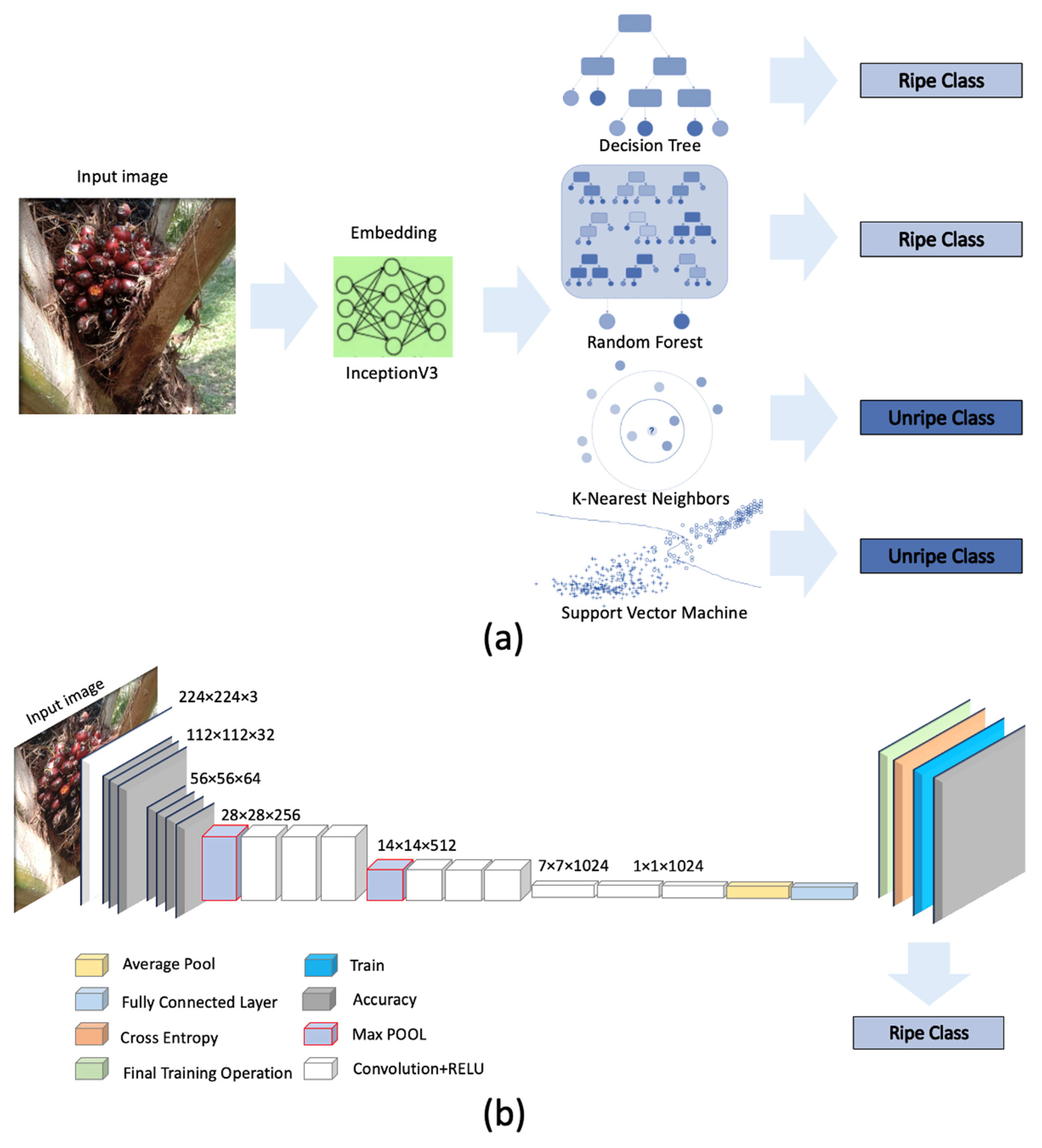
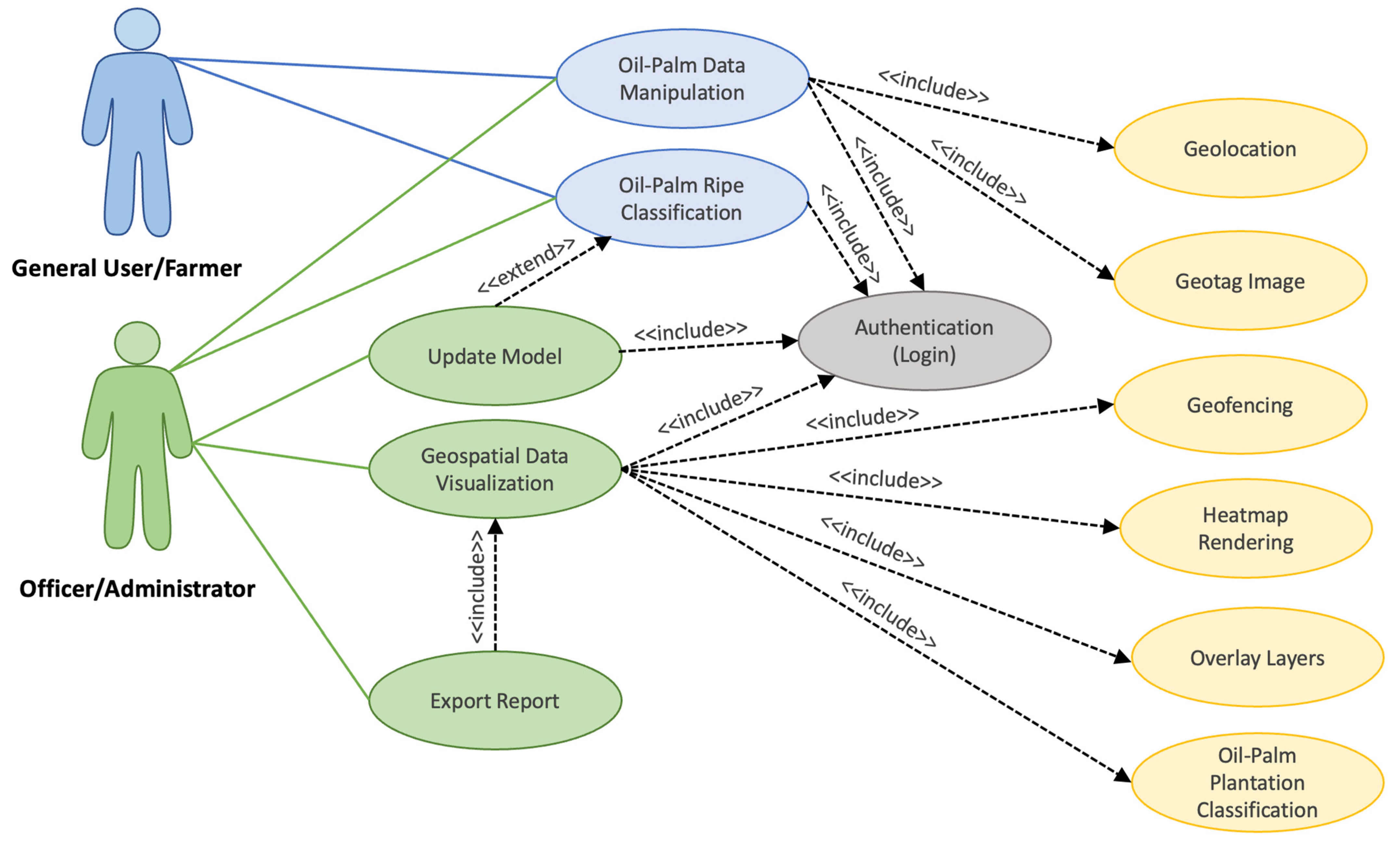
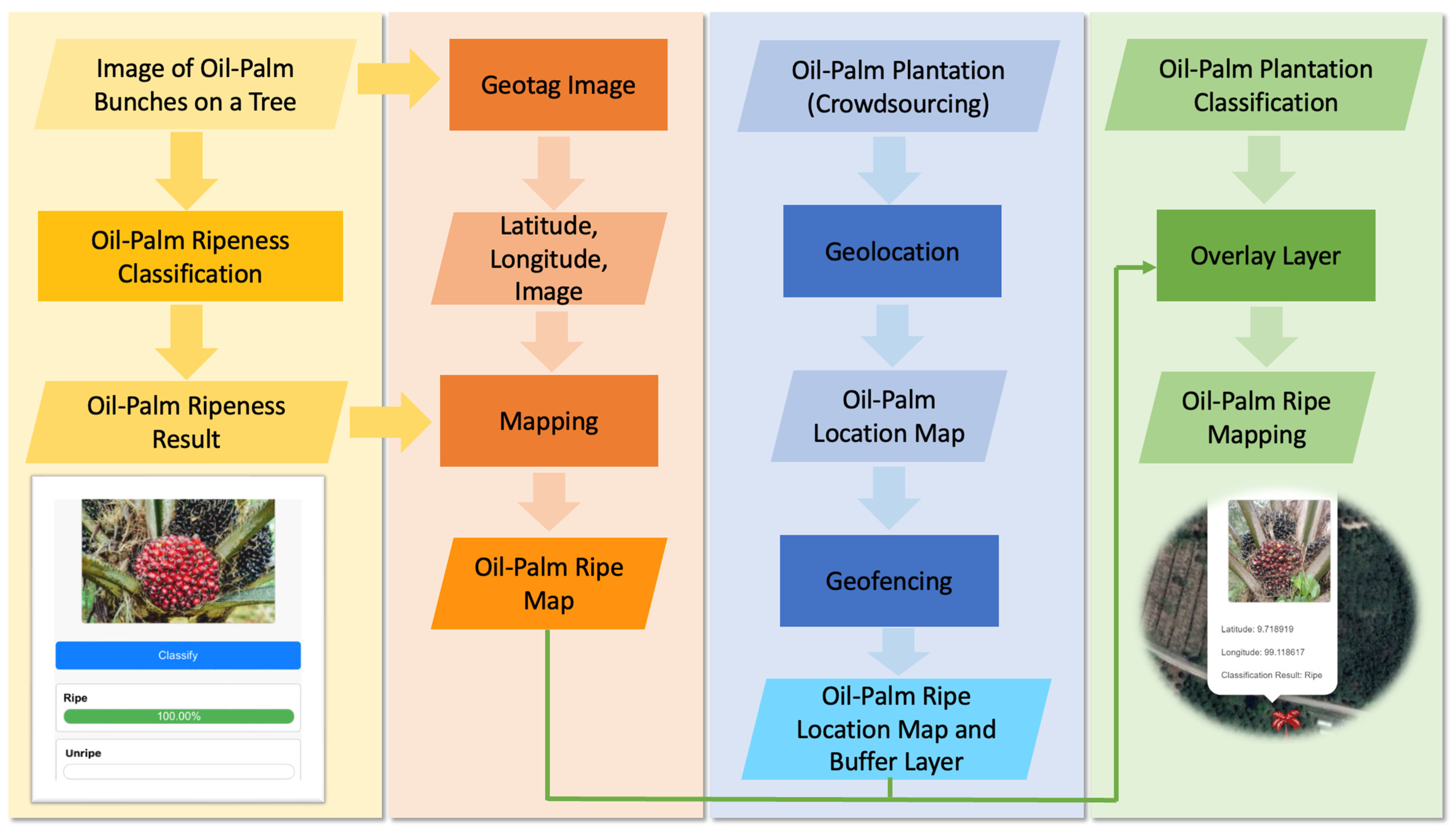
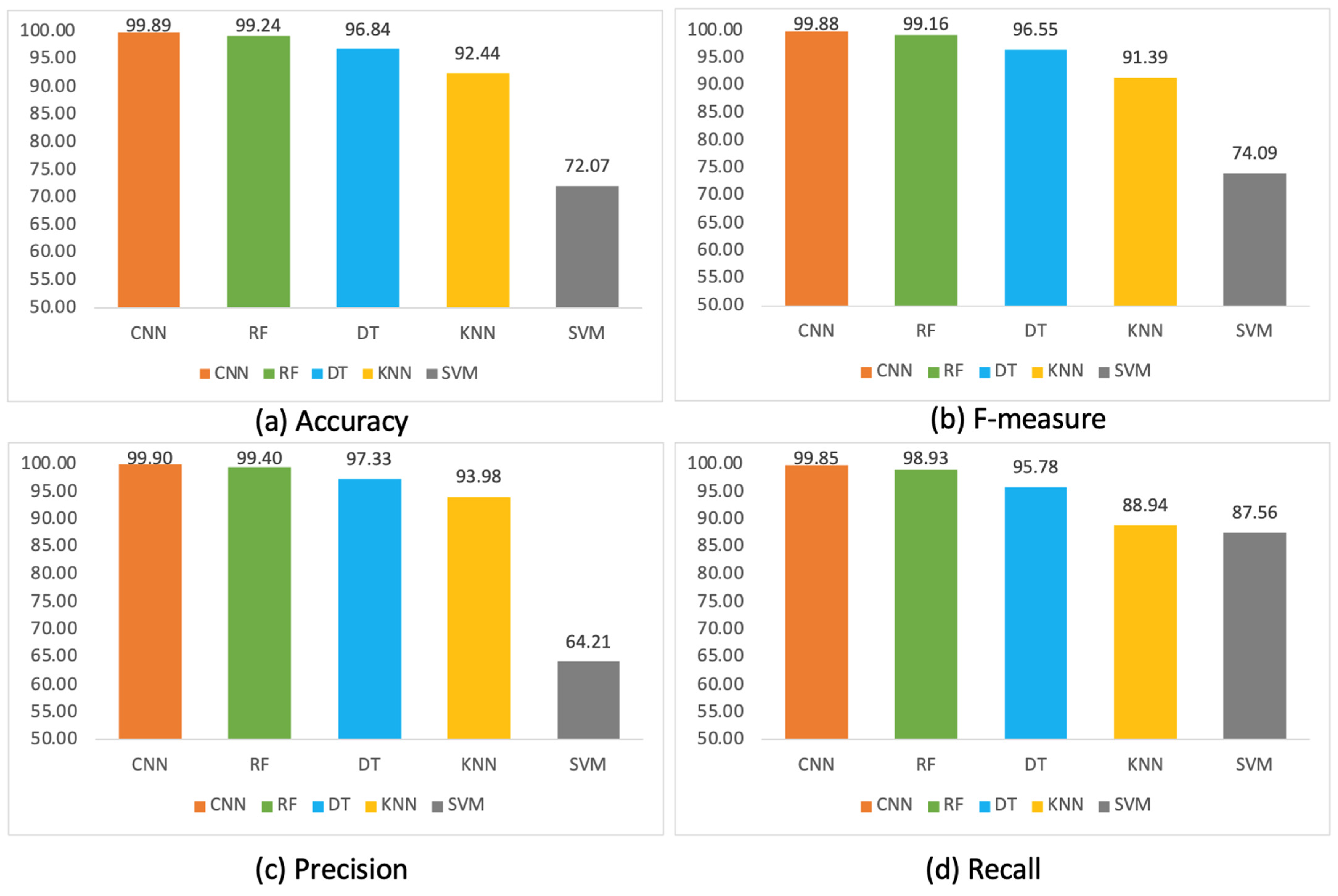
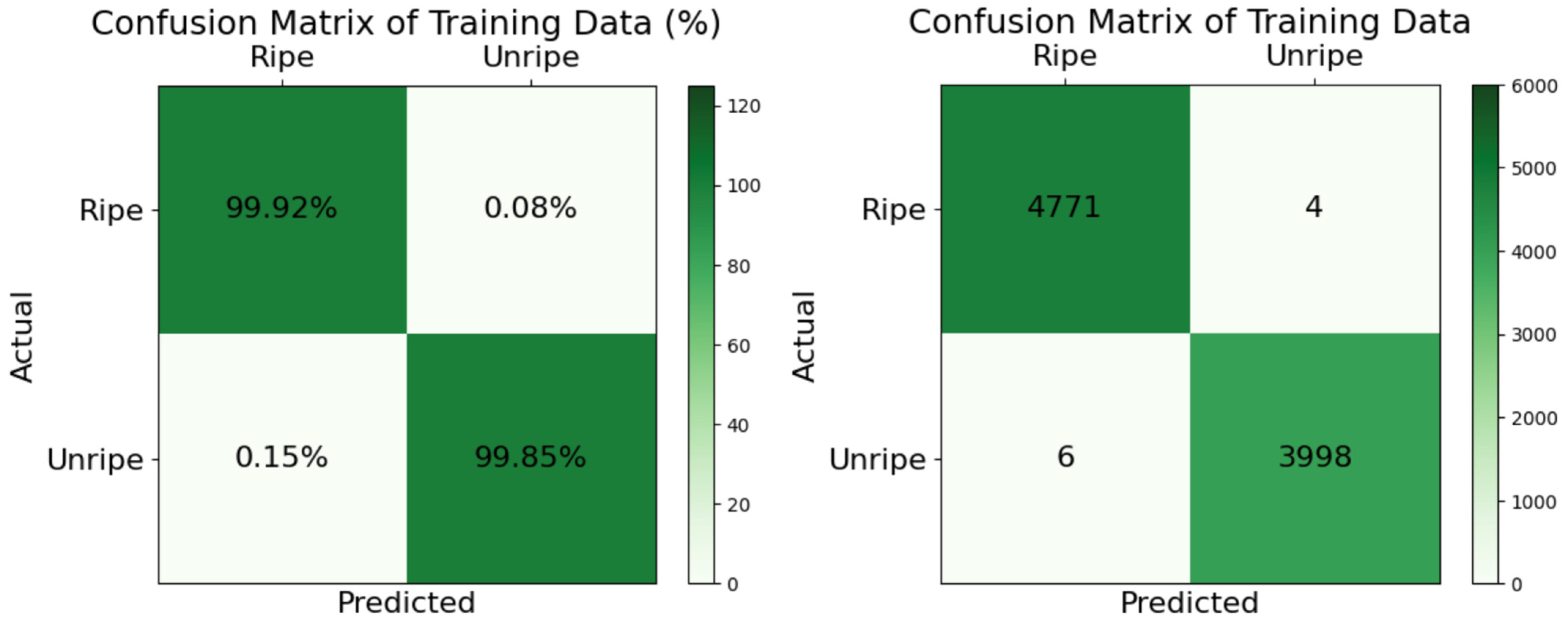
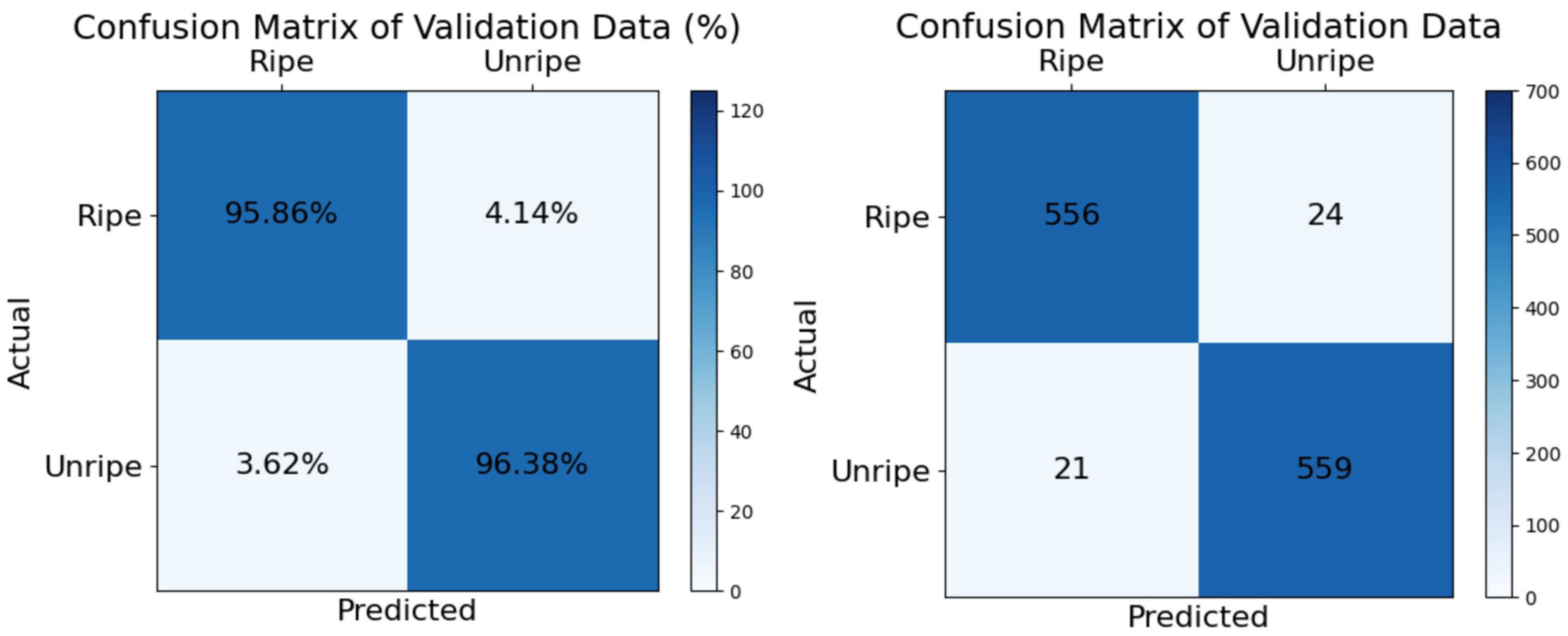
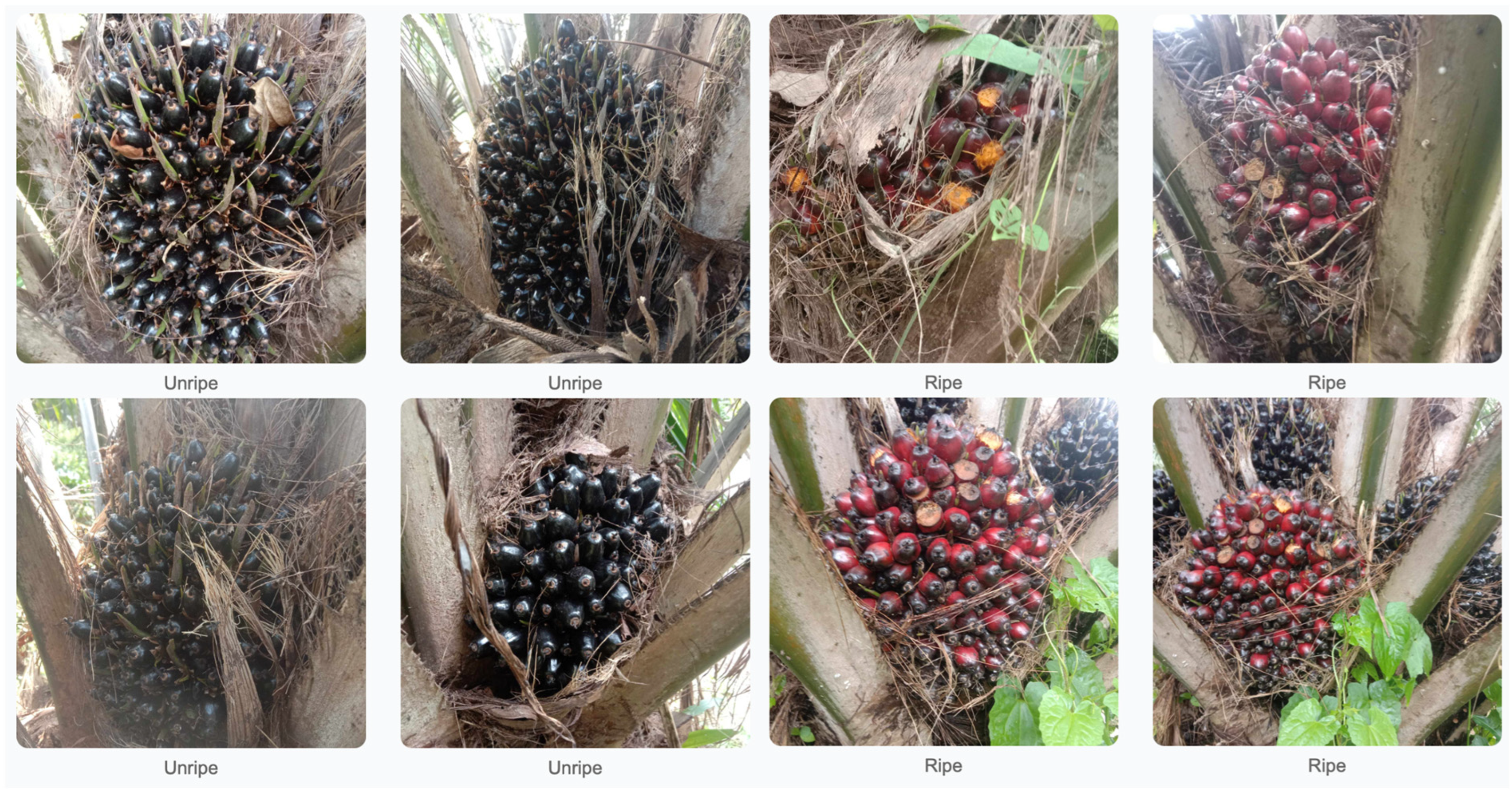
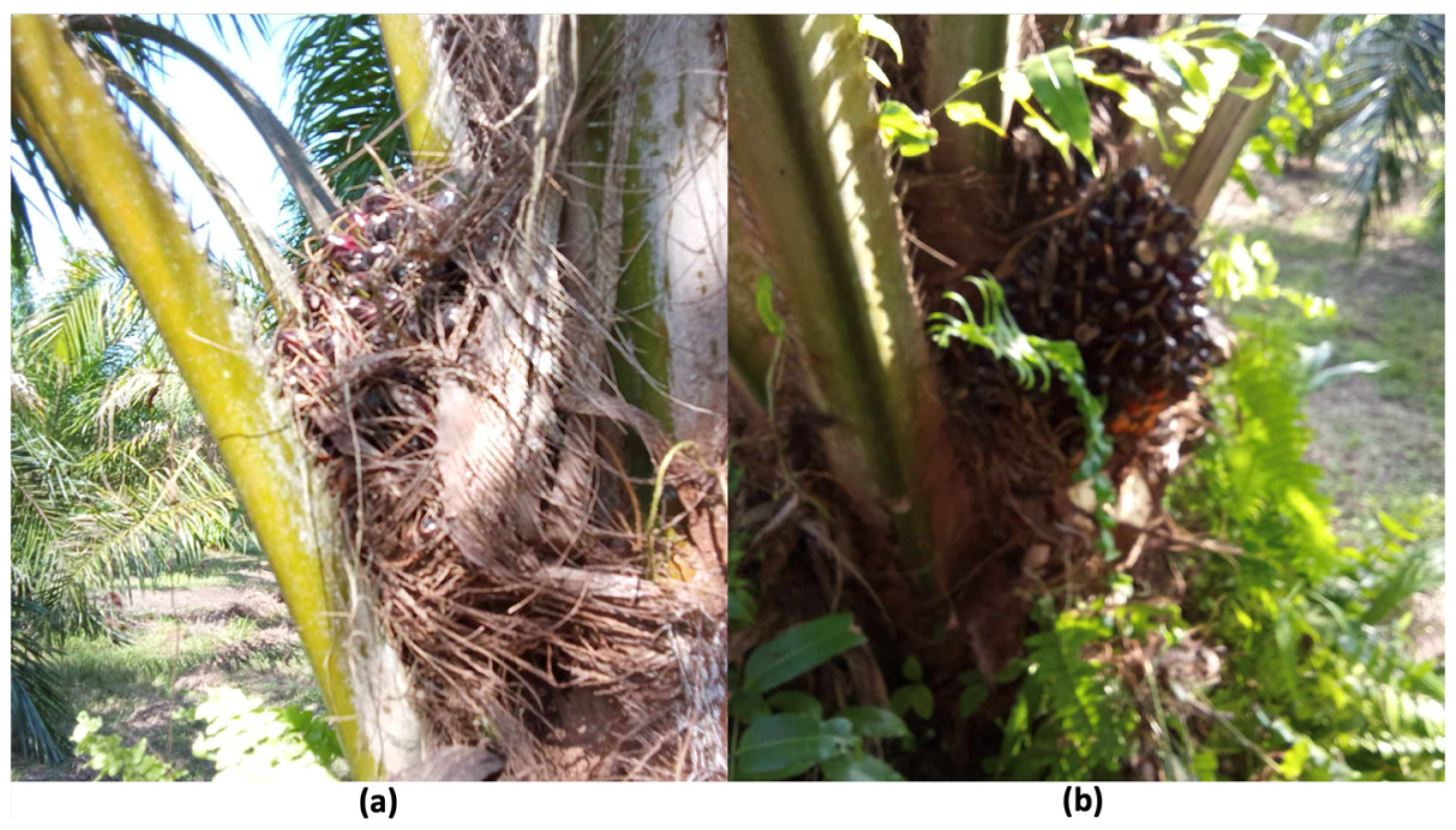
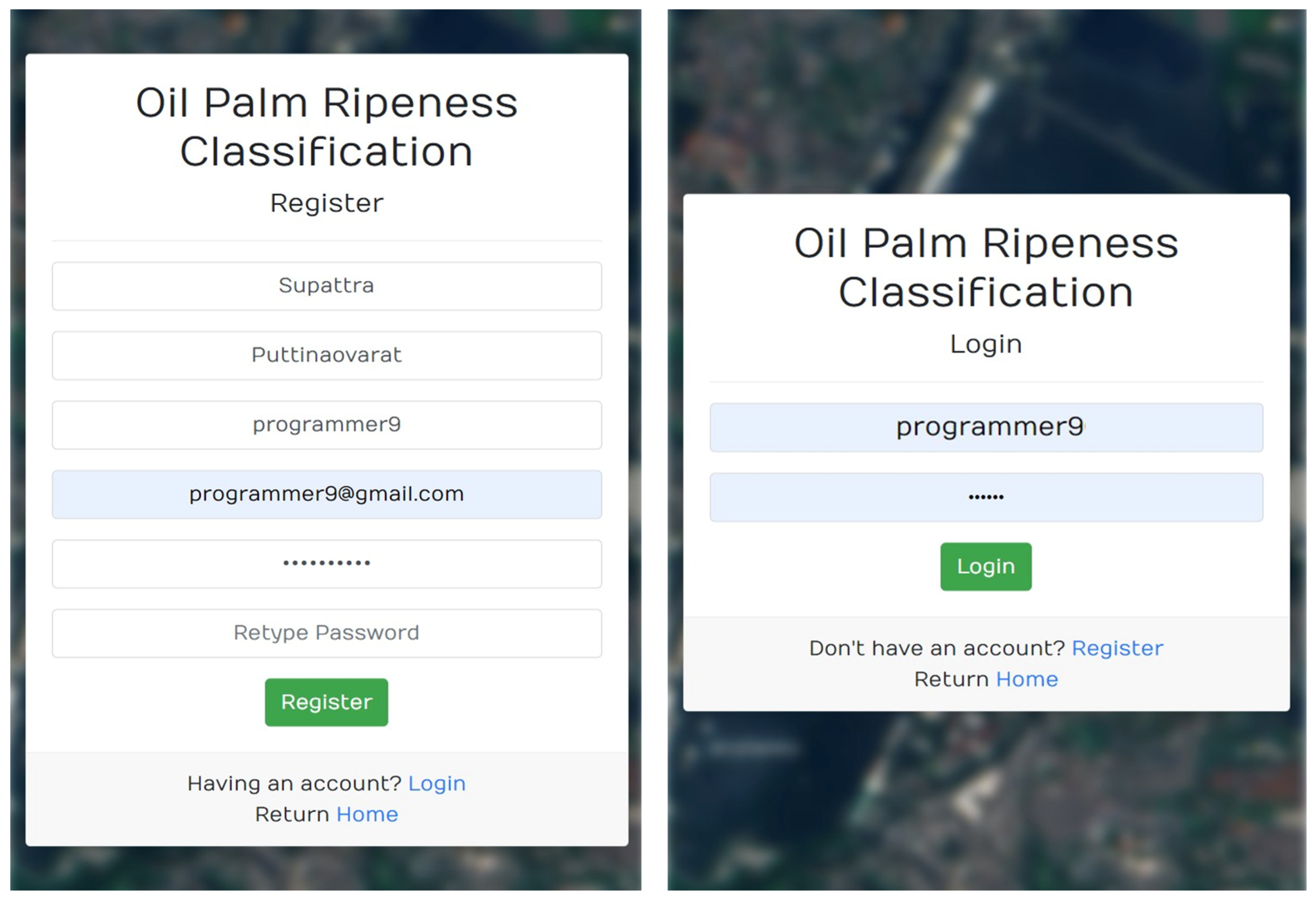
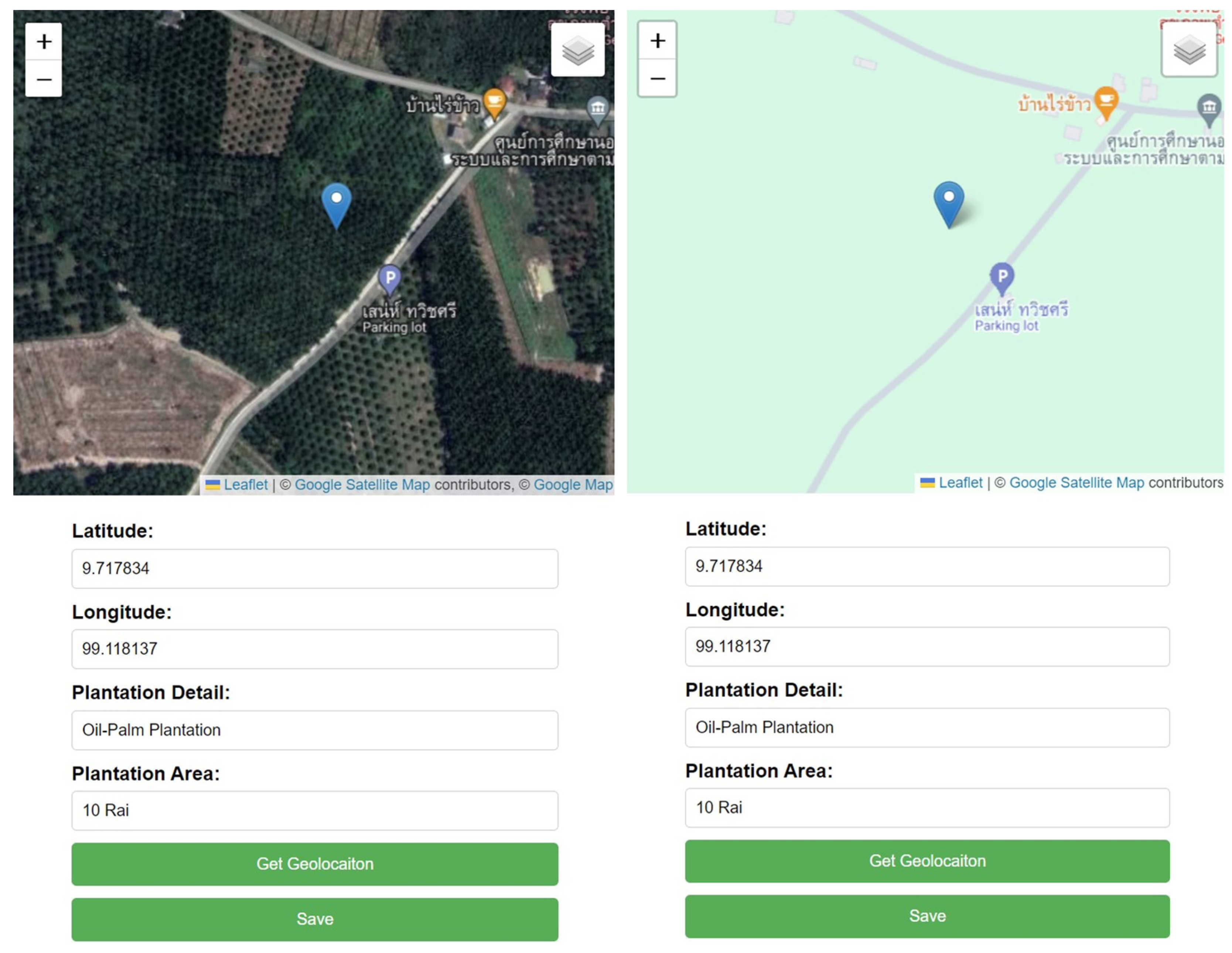
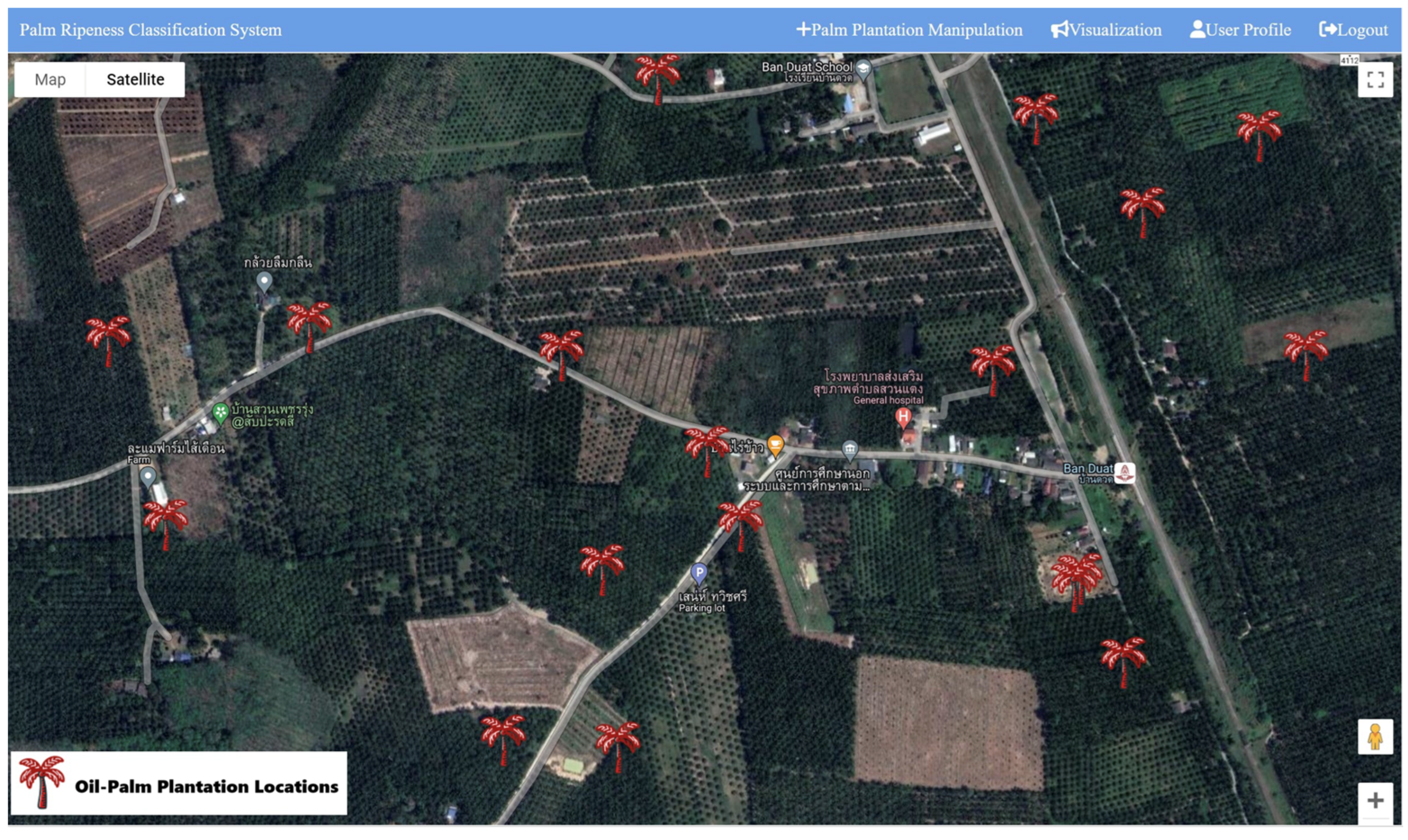

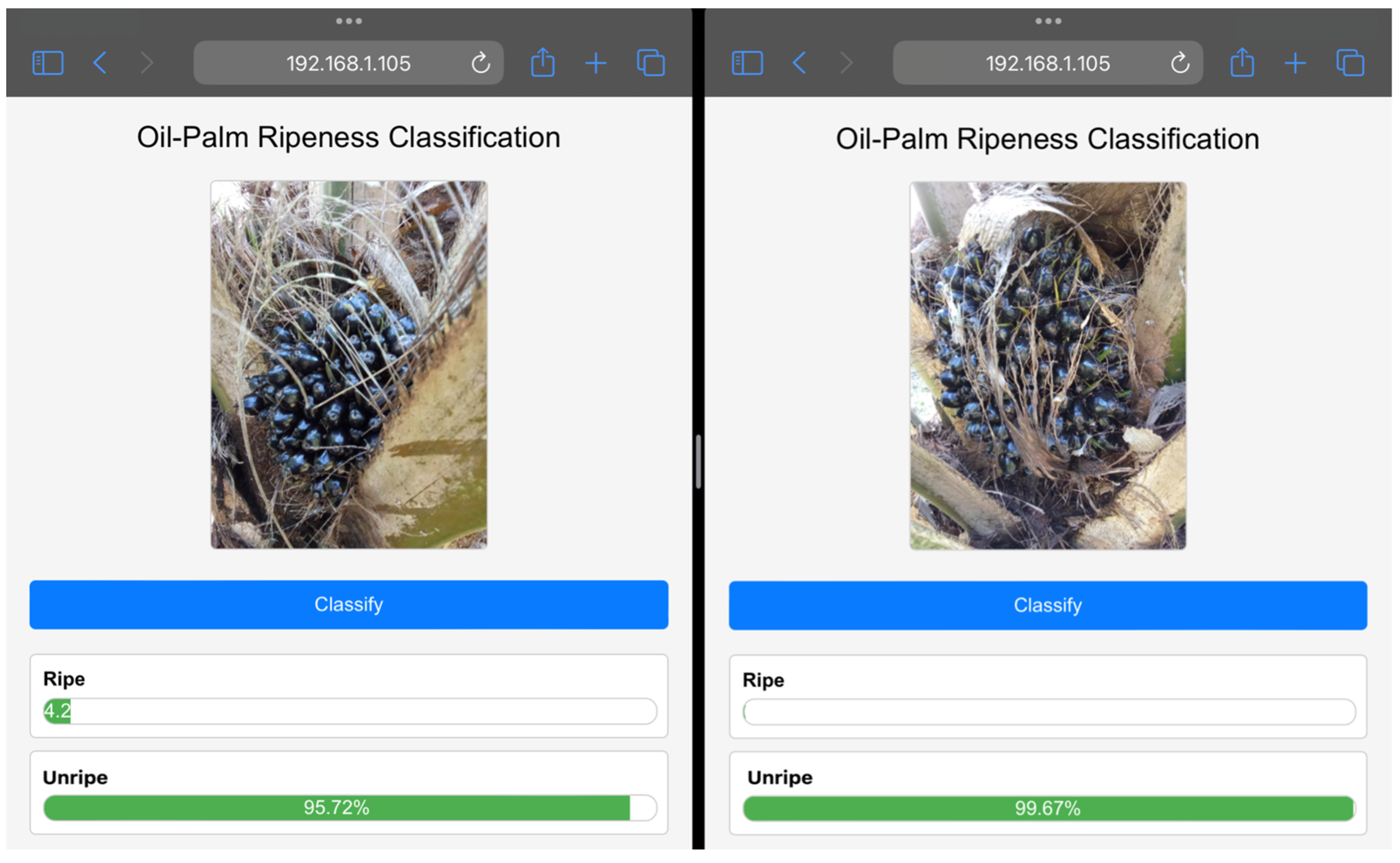

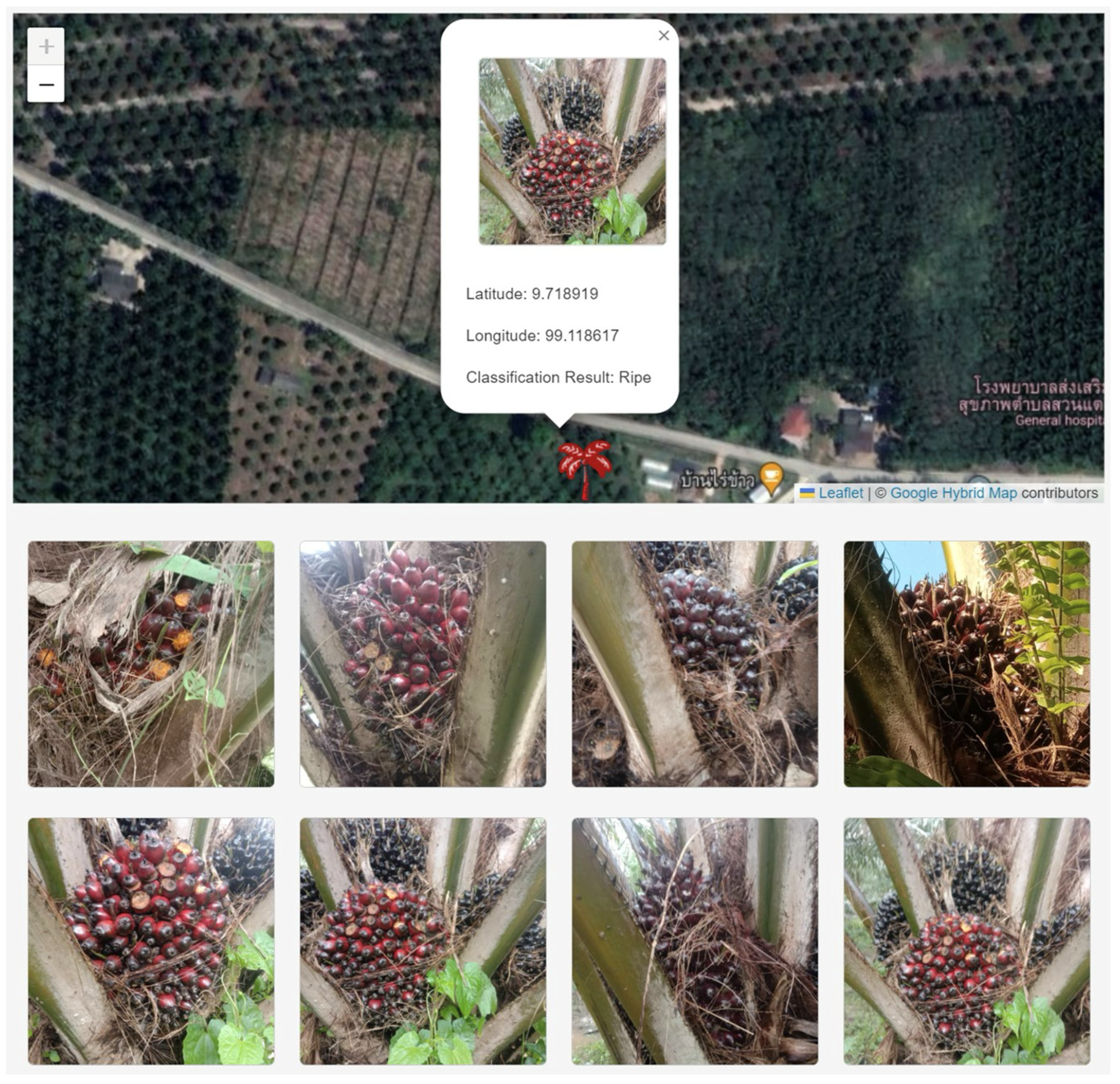
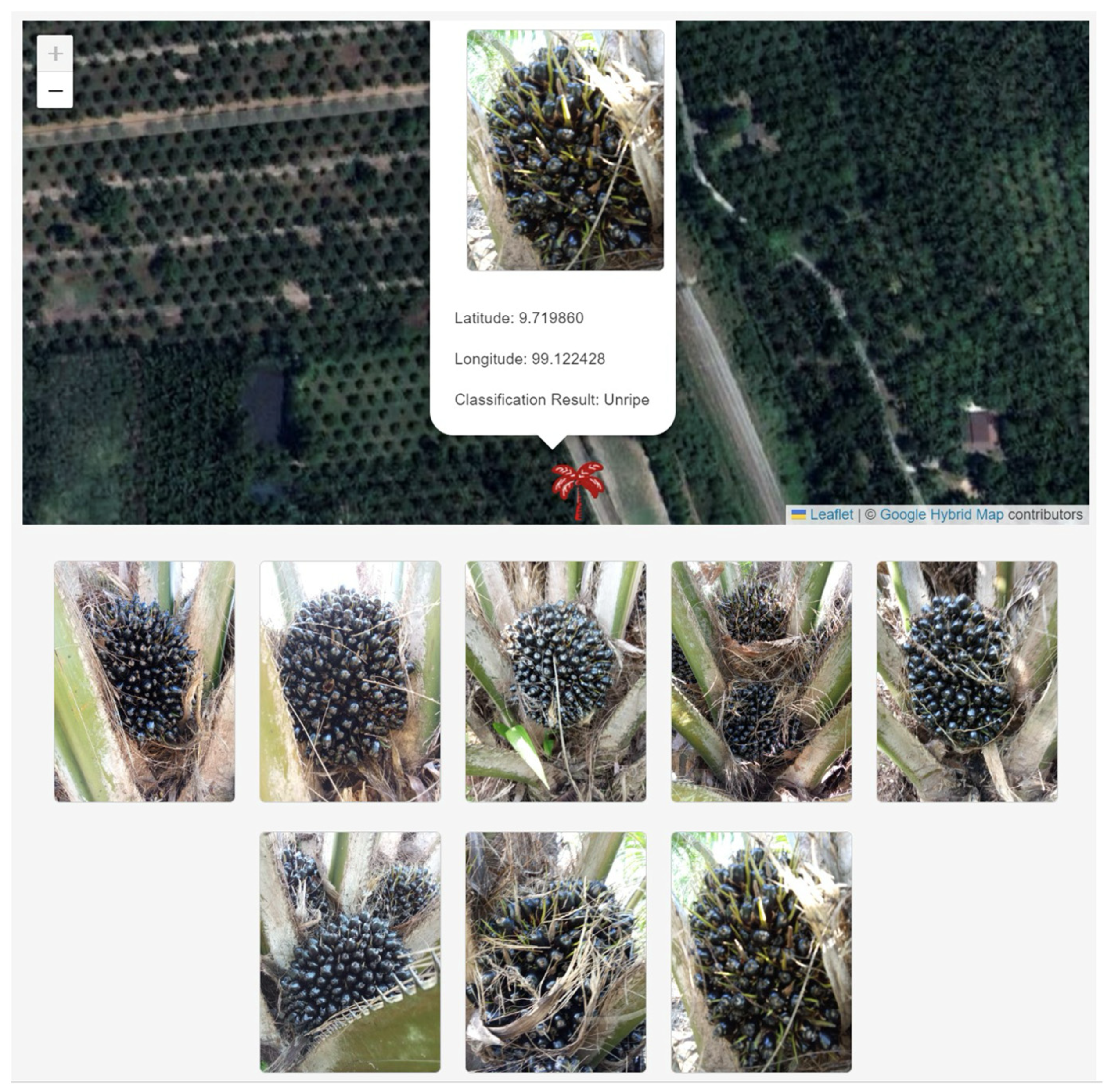
| Data | Type | Data Source | Processing Method |
|---|---|---|---|
| Google Satellite Map | Spatial data | API | |
| Google Map | Spatial data | API | |
| Oil Palm Plantation Location | Spatial and Attribute data | Crowdsource | Geospatial Analysis |
| Oil Palm Bunch Images | Image | Crowdsource | Geotag, Deep Learning |
| Oil Palm Plantation Map | Spatial Data | GEE Data Catalog | API |
| Algorithms | Epoch/Iteration/Other | Learning Rate | Kernel/Activation/Other | Image Embedding |
|---|---|---|---|---|
| CNN | Epoch = 100, Batch Size = 32 | 0.01 | RELU | - |
| RF | Number of Tree = 10 | 0.01 | - | InceptionV3 |
| DT | Maximum Tree = 100 | 0.01 | Induce binary tree | InceptionV3 |
| KNN | Number of neighbors = 5 | - | Euclidean/Uniform | InceptionV3 InceptionV3 |
| SVM | Iteration = 100 | 0.01 | RBF | InceptionV3 |
| Evaluation Method | Equation | Remark |
|---|---|---|
| Accuracy | (TP + TN)/(TP + TN + FP + FN) | TP is True Positive |
| F-measure | (2*Precision*Recall)/(Precision + Recall) | TN is True Negative |
| Precision | (TP/(TP + FP)) | FP is False Positive |
| Recall | (TP/(TP + FN)) | FN is False Negative |
| Algorithms | Accuracy | F-Measure | Precision | Recall |
|---|---|---|---|---|
| CNN | 99.89 | 99.88 | 99.90 | 99.85 |
| RF | 99.24 | 99.16 | 99.40 | 98.93 |
| DT | 96.84 | 96.55 | 97.33 | 95.78 |
| KNN | 92.44 | 91.39 | 93.98 | 88.94 |
| SVM | 72.07 | 74.09 | 64.21 | 87.56 |
| Algorithms | Accuracy | F-Measure | Precision | Recall |
|---|---|---|---|---|
| RF | 99.16 | 99.07 | 98.75 | 99.40 |
| DT | 97.80 | 97.60 | 97.83 | 97.37 |
| KNN | 91.14 | 89.99 | 87.36 | 92.28 |
| SVM | 81.00 | 78.02 | 73.93 | 82.59 |
Disclaimer/Publisher’s Note: The statements, opinions and data contained in all publications are solely those of the individual author(s) and contributor(s) and not of MDPI and/or the editor(s). MDPI and/or the editor(s) disclaim responsibility for any injury to people or property resulting from any ideas, methods, instructions or products referred to in the content. |
© 2024 by the authors. Licensee MDPI, Basel, Switzerland. This article is an open access article distributed under the terms and conditions of the Creative Commons Attribution (CC BY) license (https://creativecommons.org/licenses/by/4.0/).
Share and Cite
Puttinaovarat, S.; Chai-Arayalert, S.; Saetang, W. Oil Palm Bunch Ripeness Classification and Plantation Verification Platform: Leveraging Deep Learning and Geospatial Analysis and Visualization. ISPRS Int. J. Geo-Inf. 2024, 13, 158. https://doi.org/10.3390/ijgi13050158
Puttinaovarat S, Chai-Arayalert S, Saetang W. Oil Palm Bunch Ripeness Classification and Plantation Verification Platform: Leveraging Deep Learning and Geospatial Analysis and Visualization. ISPRS International Journal of Geo-Information. 2024; 13(5):158. https://doi.org/10.3390/ijgi13050158
Chicago/Turabian StylePuttinaovarat, Supattra, Supaporn Chai-Arayalert, and Wanida Saetang. 2024. "Oil Palm Bunch Ripeness Classification and Plantation Verification Platform: Leveraging Deep Learning and Geospatial Analysis and Visualization" ISPRS International Journal of Geo-Information 13, no. 5: 158. https://doi.org/10.3390/ijgi13050158
APA StylePuttinaovarat, S., Chai-Arayalert, S., & Saetang, W. (2024). Oil Palm Bunch Ripeness Classification and Plantation Verification Platform: Leveraging Deep Learning and Geospatial Analysis and Visualization. ISPRS International Journal of Geo-Information, 13(5), 158. https://doi.org/10.3390/ijgi13050158








